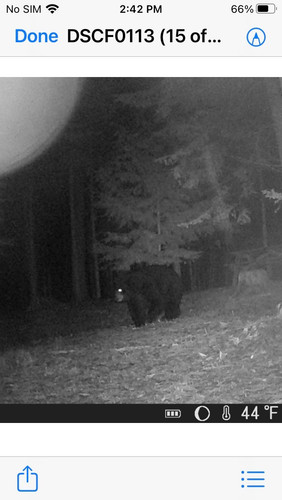- Welcome to FinsandFur.net Forums.
Recent posts
#1
The Tailgate / Today in history 5-7
Last post by remrogers - Today at 10:11:58 AM1994
May 7
Edvard Munch's "The Scream" recovered after theft
On May 7, 1994, Norway's most famous painting, "The Scream" by Edvard Munch, is recovered almost three months after it was stolen from a museum in Oslo. The fragile painting was recovered undamaged at a hotel in Asgardstrand, about 40 miles south of Oslo, police said.
The iconic 1893 painting of a waiflike figure on a bridge was stolen in only 50 seconds during a break-in on February 12, the opening day of the 1994 Winter Olympics in Lillehammer. Two thieves broke through a window of the National Gallery, cut a wire holding the painting to the wall and left a note reading "Thousand thanks for the bad security!"
A few days after the theft, a Norwegian anti-abortion group said it could have the painting returned if Norwegian television showed an anti-abortion film. The claim turned out to be false. The government also received a $1 million ransom demand on March 3, but refused to pay it due to a lack of proof that the demand was genuine.
Eventually, police found four pieces of the painting's frame in Nittedal, a suburb north of Oslo, and what may have been a cryptic message that the thieves wanted to discuss a ransom. Finally, in January 1996, four men were convicted and sentenced in connection with the theft. They included Paal Enger, who had been convicted in 1988 of stealing Munch's "The Vampire" in Oslo. Enger was sentenced this time to six-and-a-half-years in prison. He escaped while on a field trip in 1999, and was captured 12 days later in a blond wig and dark sunglasses trying to buy a train ticket to Copenhagen.
In August 2004, another version of "The Scream" was stolen along with Munch's "The Madonna," this time from the Munch Museum in Oslo. Three men were convicted in connection with that theft in May 2006. Police recovered both works in August with minor marks and tears. Yet another version of "The Scream" remained in private hands and sold on May 2, 2012, for $119.9 million.
Munch developed an emotionally charged style that served as an important forerunner of the 20th century Expressionist movement. He painted "The Scream" as part of his "Frieze of Life" series, in which sickness, death, fear, love and melancholy are central themes. He died in January 1944 at the age of 81.
May 7
Edvard Munch's "The Scream" recovered after theft
On May 7, 1994, Norway's most famous painting, "The Scream" by Edvard Munch, is recovered almost three months after it was stolen from a museum in Oslo. The fragile painting was recovered undamaged at a hotel in Asgardstrand, about 40 miles south of Oslo, police said.
The iconic 1893 painting of a waiflike figure on a bridge was stolen in only 50 seconds during a break-in on February 12, the opening day of the 1994 Winter Olympics in Lillehammer. Two thieves broke through a window of the National Gallery, cut a wire holding the painting to the wall and left a note reading "Thousand thanks for the bad security!"
A few days after the theft, a Norwegian anti-abortion group said it could have the painting returned if Norwegian television showed an anti-abortion film. The claim turned out to be false. The government also received a $1 million ransom demand on March 3, but refused to pay it due to a lack of proof that the demand was genuine.
Eventually, police found four pieces of the painting's frame in Nittedal, a suburb north of Oslo, and what may have been a cryptic message that the thieves wanted to discuss a ransom. Finally, in January 1996, four men were convicted and sentenced in connection with the theft. They included Paal Enger, who had been convicted in 1988 of stealing Munch's "The Vampire" in Oslo. Enger was sentenced this time to six-and-a-half-years in prison. He escaped while on a field trip in 1999, and was captured 12 days later in a blond wig and dark sunglasses trying to buy a train ticket to Copenhagen.
In August 2004, another version of "The Scream" was stolen along with Munch's "The Madonna," this time from the Munch Museum in Oslo. Three men were convicted in connection with that theft in May 2006. Police recovered both works in August with minor marks and tears. Yet another version of "The Scream" remained in private hands and sold on May 2, 2012, for $119.9 million.
Munch developed an emotionally charged style that served as an important forerunner of the 20th century Expressionist movement. He painted "The Scream" as part of his "Frieze of Life" series, in which sickness, death, fear, love and melancholy are central themes. He died in January 1944 at the age of 81.
#2
Predator Hunting / The good ole days
Last post by 1snafu - Today at 08:19:15 AMMost of my predator hunting experience. Has been spot/stalking since 1964. That is the hunting form I was introduced to, by our Dad & his 2 hunting buds. I hunted with them until I got my driver's license. Then branched off on my own. To have my own personal hunts & to hone my stalking skills. Needless to say, I made my share of mistakes. But they taught me what not to do for the most part. I came to understand the great sense's of a fox & coyotes natural abilities. Over coming a coyotes, sense of hearing was one of the hardest. I've found most coyotes hearing ability is top shelf. Not only that but most coyote are tuned into their hunt areas/territories.
Sneaking in on one that is bedded down for example. That coyote is stationary & not making any noise as it walks around. So the least sound it can often pick up from long range. IF...IMO, that sound does not sound natural. That coyotes ears will pivot towards that sound. Et remain aimed at it for quite awhile. Especially if that least sound continues. Such as a stalker creeping in closer.
Early-mid 80's the coyote pop was very high in my hunt areas. I would see anywhere from lower 60's up into the lower/mid 80's, coyotes per season. One Winter rather than just observing them in their natural setting. That Winter if I recall, I seen 84 coyotes. I decided to stalk in on 20 of them. Which were bedded down. I was only able to kill 14 out of that 20. So batting near 75% for my stalking skills. I didn't figure that wasn't to bad.
Since the early & mid 1980's. The coyote populations have declined. I doubt I ever see those high counts again. Things have changed & not for the good, I figure. I long for the good ole days.
Sneaking in on one that is bedded down for example. That coyote is stationary & not making any noise as it walks around. So the least sound it can often pick up from long range. IF...IMO, that sound does not sound natural. That coyotes ears will pivot towards that sound. Et remain aimed at it for quite awhile. Especially if that least sound continues. Such as a stalker creeping in closer.
Early-mid 80's the coyote pop was very high in my hunt areas. I would see anywhere from lower 60's up into the lower/mid 80's, coyotes per season. One Winter rather than just observing them in their natural setting. That Winter if I recall, I seen 84 coyotes. I decided to stalk in on 20 of them. Which were bedded down. I was only able to kill 14 out of that 20. So batting near 75% for my stalking skills. I didn't figure that wasn't to bad.
Since the early & mid 1980's. The coyote populations have declined. I doubt I ever see those high counts again. Things have changed & not for the good, I figure. I long for the good ole days.
#3
Non Hunting/Fishing Photos / Re: Is it time Jim?
Last post by FinsnFur - Today at 05:40:04 AMQuote from: Todd Rahm on Yesterday at 06:30:26 AMAh, walleyes might be a blast in a kayak (I have never fished for or caught one.)
The Walleye wouldn't be the challenge. Bowfin (dogfish) and Gar are the real challenge in a kayak.
The Walleyes up here are biting by the dams. The Locks and Dams. Which is a huge hydraulic mechanism that spans the width of the river. The water is different heights on each side. They open the gates on one side and allows barges and boats to enter a walled pool. They lift or lower the water to match the other side in that walled section only, lifting or lowering the boats inside and then open the gate and let them out the other side.
The turbulence is absolutely incredible during this. Nothing you want to be near in a kayak.
Walleye fisherman in boats typically have their motors in gear during jigging for Wallayes by the dams because the raising and lower of the water when opening and closing sucks you towards the rollers.
#4
The Tailgate / Today in history 5-6
Last post by remrogers - Yesterday at 10:21:25 AM1937
May 6
The Hindenburg disaster
The airship Hindenburg, the largest dirigible ever built and the pride of Nazi Germany, bursts into flames upon touching its mooring mast in Lakehurst, New Jersey, killing 36 passengers and crew-members, on May 6, 1937.
Frenchman Henri Giffard constructed the first successful airship in 1852. His hydrogen-filled blimp carried a three-horsepower steam engine that turned a large propeller and flew at a speed of six miles per hour. The rigid airship, often known as the "zeppelin" after the last name of its innovator, Count Ferdinand von Zeppelin, was developed by the Germans in the late 19th century. Unlike French airships, the German ships had a light framework of metal girders that protected a gas-filled interior. However, like Giffard's airship, they were lifted by highly flammable hydrogen gas and vulnerable to explosion. Large enough to carry substantial numbers of passengers, one of the most famous rigid airships was the Graf Zeppelin, a dirigible that traveled around the world in 1929. In the 1930s, the Graf Zeppelin pioneered the first transatlantic air service, leading to the construction of the Hindenburg, a larger passenger airship.
On May 3, 1937, the Hindenburg left Frankfurt, Germany, for a journey across the Atlantic to Lakehurst's Navy Air Base. Stretching 804 feet from stern to bow, it carried 36 passengers and crew of 61. While attempting to moor at Lakehurst, the airship suddenly burst into flames, probably after a spark ignited its hydrogen core. Rapidly falling 200 feet to the ground, the hull of the airship incinerated within seconds. Thirteen passengers, 21 crewmen, and 1 civilian member of the ground crew lost their lives, and most of the survivors suffered substantial injuries.
Radio announcer Herb Morrison, who came to Lakehurst to record a routine voice-over for an NBC newsreel, immortalized the Hindenberg disaster in a famous on-the-scene description in which he emotionally declared, "Oh, the humanity!" The recording of Morrison's commentary was immediately flown to New York, where it was aired as part of America's first coast-to-coast radio news broadcast. Lighter-than-air passenger travel rapidly fell out of favor after the Hindenberg disaster, and no rigid airships survived World War II.
May 6
The Hindenburg disaster
The airship Hindenburg, the largest dirigible ever built and the pride of Nazi Germany, bursts into flames upon touching its mooring mast in Lakehurst, New Jersey, killing 36 passengers and crew-members, on May 6, 1937.
Frenchman Henri Giffard constructed the first successful airship in 1852. His hydrogen-filled blimp carried a three-horsepower steam engine that turned a large propeller and flew at a speed of six miles per hour. The rigid airship, often known as the "zeppelin" after the last name of its innovator, Count Ferdinand von Zeppelin, was developed by the Germans in the late 19th century. Unlike French airships, the German ships had a light framework of metal girders that protected a gas-filled interior. However, like Giffard's airship, they were lifted by highly flammable hydrogen gas and vulnerable to explosion. Large enough to carry substantial numbers of passengers, one of the most famous rigid airships was the Graf Zeppelin, a dirigible that traveled around the world in 1929. In the 1930s, the Graf Zeppelin pioneered the first transatlantic air service, leading to the construction of the Hindenburg, a larger passenger airship.
On May 3, 1937, the Hindenburg left Frankfurt, Germany, for a journey across the Atlantic to Lakehurst's Navy Air Base. Stretching 804 feet from stern to bow, it carried 36 passengers and crew of 61. While attempting to moor at Lakehurst, the airship suddenly burst into flames, probably after a spark ignited its hydrogen core. Rapidly falling 200 feet to the ground, the hull of the airship incinerated within seconds. Thirteen passengers, 21 crewmen, and 1 civilian member of the ground crew lost their lives, and most of the survivors suffered substantial injuries.
Radio announcer Herb Morrison, who came to Lakehurst to record a routine voice-over for an NBC newsreel, immortalized the Hindenberg disaster in a famous on-the-scene description in which he emotionally declared, "Oh, the humanity!" The recording of Morrison's commentary was immediately flown to New York, where it was aired as part of America's first coast-to-coast radio news broadcast. Lighter-than-air passenger travel rapidly fell out of favor after the Hindenberg disaster, and no rigid airships survived World War II.
#5
Non Hunting/Fishing Photos / Re: Is it time Jim?
Last post by Todd Rahm - Yesterday at 06:30:26 AMI'll drag mine out this week for some work, and hopefully in the water by next week. The LM Bass should be bedded up by now. 🥰
Ah, walleyes might be a blast in a kayak (I have never fished for or caught one.)
Ah, walleyes might be a blast in a kayak (I have never fished for or caught one.)
#6
Non Hunting/Fishing Photos / Big Bubba
Last post by nastygunz - May 05, 2024, 05:07:55 PM #7
The Tailgate / Today in history 5-5
Last post by remrogers - May 05, 2024, 11:41:12 AM1945
May 5
Six killed in Oregon by Japanese bomb
In Gearhart Mountain, Oregon, Mrs. Elsie Mitchell and five neighborhood children are killed while attempting to drag a Japanese balloon out of the woods. Unbeknownst to Mitchell and the children, the balloon was armed, and it exploded soon after they began tampering with it. They were the first and only known American civilians to be killed in the continental United States during World War II. The U.S. government eventually gave $5,000 in compensation to Mitchell's husband, and $3,000 each to the families of Edward Engen, Sherman Shoemaker, Jay Gifford and Richard and Ethel Patzke, the five slain children.
The explosive balloon found at Lakeview was a product of one of only a handful of Japanese attacks against the continental United States, which were conducted early in the war by Japanese submarines and later by high-altitude balloons carrying explosives or incendiaries. In comparison, three years earlier, on April 18, 1942, the first squadron of U.S. bombers dropped bombs on the Japanese cities of Tokyo, Kobe and Nagoya, surprising the Japanese military command, who believed their home islands to be out of reach of Allied air attacks. When the war ended on August 14, 1945, some 160,000 tons of conventional explosives and two atomic bombs had been dropped on Japan by the United States. Approximately 500,000 Japanese civilians were killed as a result of these bombing attacks.
May 5
Six killed in Oregon by Japanese bomb
In Gearhart Mountain, Oregon, Mrs. Elsie Mitchell and five neighborhood children are killed while attempting to drag a Japanese balloon out of the woods. Unbeknownst to Mitchell and the children, the balloon was armed, and it exploded soon after they began tampering with it. They were the first and only known American civilians to be killed in the continental United States during World War II. The U.S. government eventually gave $5,000 in compensation to Mitchell's husband, and $3,000 each to the families of Edward Engen, Sherman Shoemaker, Jay Gifford and Richard and Ethel Patzke, the five slain children.
The explosive balloon found at Lakeview was a product of one of only a handful of Japanese attacks against the continental United States, which were conducted early in the war by Japanese submarines and later by high-altitude balloons carrying explosives or incendiaries. In comparison, three years earlier, on April 18, 1942, the first squadron of U.S. bombers dropped bombs on the Japanese cities of Tokyo, Kobe and Nagoya, surprising the Japanese military command, who believed their home islands to be out of reach of Allied air attacks. When the war ended on August 14, 1945, some 160,000 tons of conventional explosives and two atomic bombs had been dropped on Japan by the United States. Approximately 500,000 Japanese civilians were killed as a result of these bombing attacks.
#8
Fishing Equipment / Fishing stuff.
Last post by nastygunz - May 04, 2024, 12:40:22 PM #9
The Tailgate / Today in history 5-4
Last post by remrogers - May 04, 2024, 09:08:00 AM1970
May 4
National Guard kills four students in Kent State shootings
Photo Credit: CSU Archives/Everett Collection
On May 4, 1970, in Kent, Ohio, 28 National Guardsmen fire their weapons at a group of anti-war demonstrators on the Kent State University campus, killing four students, wounding eight and permanently paralyzing another. The tragedy was a watershed moment for a nation divided by the conflict in Vietnam, and further galvanized the anti-war movement.
Two days earlier, on May 2, National Guard troops were called to Kent to suppress students rioting in protest of the Vietnam War and the U.S. invasion of Cambodia. The next day, scattered protests were dispersed by tear gas, and on May 4 class resumed at Kent State University. By noon that day, despite a ban on rallies, some 2,000 people had assembled on the campus. National Guard troops arrived and ordered the crowd to disperse, fired tear gas, and advanced against the students with bayonets fixed on their rifles. Some of the protesters, refusing to yield, responded by throwing rocks and verbally taunting the troops.
Minutes later, without firing a warning shot, the Guardsmen discharged more than 60 rounds toward a group of demonstrators in a nearby parking lot, killing four and wounding nine. The closest casualty was 20 yards away, and the farthest was almost 250 yards away. After a period of disbelief, shock, and attempts at first aid, angry students gathered on a nearby slope and were again ordered to move by the Guardsmen. Faculty members were able to convince the group to disperse, and further bloodshed was prevented.
The shootings led to protests on college campuses across the country. Photographs of the massacre became enduring images of the anti-war movement. In 1974, at the end of a criminal investigation, a federal court dropped all charges levied against eight Ohio National Guardsmen for their role in the Kent State students' deaths.
May 4
National Guard kills four students in Kent State shootings
Photo Credit: CSU Archives/Everett Collection
On May 4, 1970, in Kent, Ohio, 28 National Guardsmen fire their weapons at a group of anti-war demonstrators on the Kent State University campus, killing four students, wounding eight and permanently paralyzing another. The tragedy was a watershed moment for a nation divided by the conflict in Vietnam, and further galvanized the anti-war movement.
Two days earlier, on May 2, National Guard troops were called to Kent to suppress students rioting in protest of the Vietnam War and the U.S. invasion of Cambodia. The next day, scattered protests were dispersed by tear gas, and on May 4 class resumed at Kent State University. By noon that day, despite a ban on rallies, some 2,000 people had assembled on the campus. National Guard troops arrived and ordered the crowd to disperse, fired tear gas, and advanced against the students with bayonets fixed on their rifles. Some of the protesters, refusing to yield, responded by throwing rocks and verbally taunting the troops.
Minutes later, without firing a warning shot, the Guardsmen discharged more than 60 rounds toward a group of demonstrators in a nearby parking lot, killing four and wounding nine. The closest casualty was 20 yards away, and the farthest was almost 250 yards away. After a period of disbelief, shock, and attempts at first aid, angry students gathered on a nearby slope and were again ordered to move by the Guardsmen. Faculty members were able to convince the group to disperse, and further bloodshed was prevented.
The shootings led to protests on college campuses across the country. Photographs of the massacre became enduring images of the anti-war movement. In 1974, at the end of a criminal investigation, a federal court dropped all charges levied against eight Ohio National Guardsmen for their role in the Kent State students' deaths.
#10
Non Hunting/Fishing Photos / Re: Oh-Oh!
Last post by nastygunz - May 04, 2024, 08:07:57 AMYupp lol.






